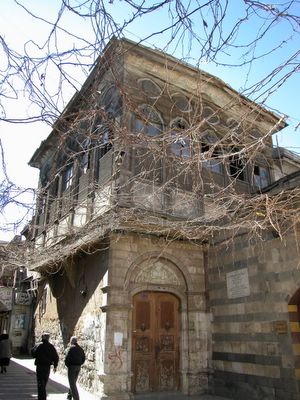10/06/2005
9/20/2005
Copyrights... again!
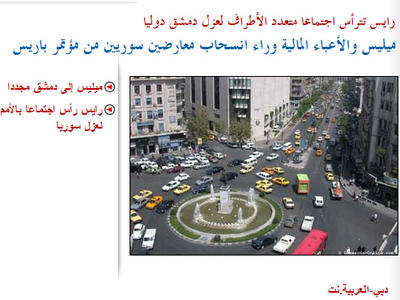 OK this has not become a copyright-watch blog... My studies have been keeping me away from blogging recently, but this morning I was browsing the web for home news and I discovered that the popular pan-Arab news wbesite Alarabiya.net republished a picture from Damascus-Online.com in a news piece about Syria and did not give any credit for it! I was with Amr when we took this picture of Youssef Al-Azmeh Square from atop the Muhafaza Building a couple of years ago (Remember Amr?) It's good they did not crop the part that has my stamp on the lower right corner, though you will need a microscope to read it!
OK this has not become a copyright-watch blog... My studies have been keeping me away from blogging recently, but this morning I was browsing the web for home news and I discovered that the popular pan-Arab news wbesite Alarabiya.net republished a picture from Damascus-Online.com in a news piece about Syria and did not give any credit for it! I was with Amr when we took this picture of Youssef Al-Azmeh Square from atop the Muhafaza Building a couple of years ago (Remember Amr?) It's good they did not crop the part that has my stamp on the lower right corner, though you will need a microscope to read it!Update (20/9): I wrote to Alarabiya. They apologized and removed the picture from the article.
Update (26/9): They used the same picture again in another news article. What's wrong with these guys?!
8/30/2005
Love...
"Love knows not its own depth until the hour of separation"
8/26/2005
Copyrights!
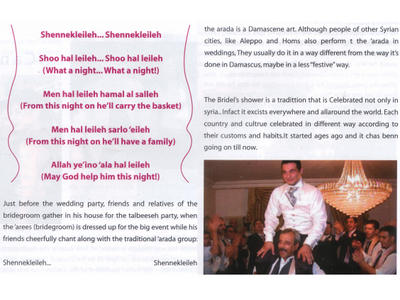 Without acquiring authorization or giving credit, the English version of Layalina Magazine has copied and pasted a post from the Damascene Blog in its latest edition. The Magazine also republished the picture in that same post and did not bother to mention the source anywhere in the article that carried the signature of the Magazine's managing editor.
Without acquiring authorization or giving credit, the English version of Layalina Magazine has copied and pasted a post from the Damascene Blog in its latest edition. The Magazine also republished the picture in that same post and did not bother to mention the source anywhere in the article that carried the signature of the Magazine's managing editor.
8/21/2005
Empty Tomb
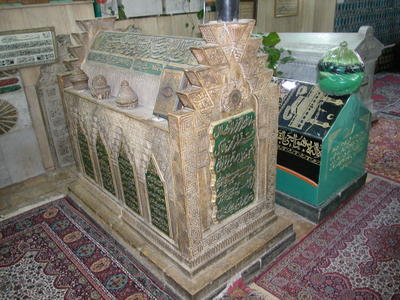 The empty tomb of Algerian national hero Abul Qadir Al-Jazairi (1808-1883), leader of the famous rebellion against the French invasion of Algeria in the mid-19th century. After losing several battles against Abdul Qadir, the French had to bring more enforcements into the country and practiced a scorched-earth policy to terrorize the population. Abdul Qadir was forced to surrender in 1847 and was later exiled to France. He remained there until 1852 when he moved to Bursa, Turkey, and then to Damascus in 1855.
The empty tomb of Algerian national hero Abul Qadir Al-Jazairi (1808-1883), leader of the famous rebellion against the French invasion of Algeria in the mid-19th century. After losing several battles against Abdul Qadir, the French had to bring more enforcements into the country and practiced a scorched-earth policy to terrorize the population. Abdul Qadir was forced to surrender in 1847 and was later exiled to France. He remained there until 1852 when he moved to Bursa, Turkey, and then to Damascus in 1855.In Damascus, he devoted himself to teaching and writing, and quickly gained popularity and respect among Syrians. In 1860, when sectarian violence broke out in Damascus, he provided refuge for more than 15,000 Christians who escaped the fighting, and helped to bring back peace and calm. He died in 1883 and was buried in the Mosque of Ibn Arabi in Damascus.
The remains of Abdul Qadir were brought back to Algeria on July 5, 1966, four years after Algerian independence and 136 years after the French invasion of Algeria.
8/11/2005
The Gorge
Maaloula is a small mountainous village located 50 km to the north-east of Damascus. It is famous for being one of the very few places in the world where people still speak Aramaic, the language of Jesus Christ. One of the highlights of Maaloula is the Fajj (gorge), a split that cuts through the mountains of Maaloula forming a beautiful narrow corridor. It is believed that the fajj is related to the story of St. Thecla (Arabic Taqla), the first girl martyr in Christianity. After converting to Christianity, Thecla was prosecuted by her family and by the Roman authorities. She was being chased by Roman soldiers when she faced a huge mountain, a dead end with no chances for escape. She prayed to God to save her and her prayer was miraculously answered when the rocks were split, forming a narrow passage: The fajj. This is where the village probably derives its name from; the word Maaloula in Aramaic means 'entrance'.
8/10/2005
Blogging Survey
I got this from a friend:
I'm currently doing some research for my Masters about blogging in Lebanon, Syria and Jordan at the University of Westminster. I've just designed a questionnaire and would be grateful if you could fill it on (its for anyone of the above origins or living in these countries). It only takes about 8 minutes.
All your responses and any comments will be treated with the utmost confidentiality. The results of this research should be very exciting and, by the end of august, I will be sharing them with everyone. If you have questions at any time about the survey or the procedures, you may contact, myself, Maha Taki on +44(0)7916161035 or email me at the email mahataki(at)gmail.com.
8/03/2005
Alley of Waterwheels

The oldest and only surviving waterwheel in Damascus is in As-Salhieh district on the slopes of Mount Qassiyoun. This water-raising device dates back to the Ayubid era and was designed by Badi' Al-Zaman Al Jazari
The waterwheel used to carry water from Yazid River to a 12-meter-high canal ending in the nearby Al-Bimaristan Al-Qaymari Hospital. It remained in use until the early 1970s. Many other waterwheels existed in the area, which is still known as Ziqaq Al-Nawa'ir (Alley of Waterwheels).
Update: My friend GottfriedStutz left some very informative comments about Al-Jazari.
7/31/2005
Take Off!
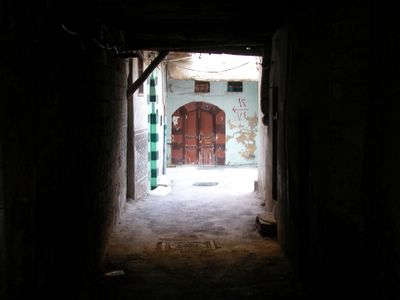
Oh Damascus, the summer is back again.
And my wings are, too.
My yearning to you cries out: "Take off!"
And the wind calls upon me.
The voices of my friends,
Her eyes,
And the promise of a possible tomorrow...
Everything I love
Has stolen sleep from my eyes
Then went to sleep.
From a song by Fairouz to the lyrics of Said Akel.
7/24/2005
Suicidal Battle
Translation:
Maysaloun Street: In memory of the Battle of Maysaloun, a suicidal battle fought on July 24th, 1920 to defend Damascus against French forces. Defense Minister Youssef Al-Azmah was martyred during the fighting.Although he knew that his poorly-equipped army will be overwhelmed by the French, Youssef Al-Azmah, Defense Minister of then newly independent Syria, did not want Damascus to be an easy get for General Gouraud, so he led 4000 men to fight the French army at Maysaloun, 25 km to the west of Damascus. The battle lasted for a few hours, the Syrian army was defeated and Al-Azmah was killed. For Syrians, he became a symbol of courage, sacrifice and dignity.
7/20/2005
Golden Flowing
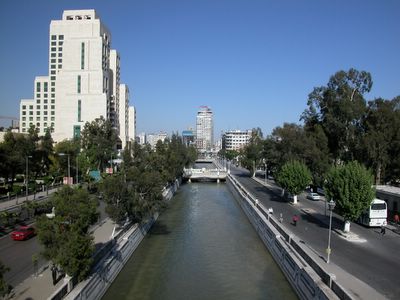
River Barada in Downtown Damascus.
Barada used to be known as the "artery of Damascus." It irrigated the oasis of Damascus, which largely consisted of the beautiful orchards of Al-Ghouta. In old times, the river was famed for its purity and crystal-clear water. The Greeks called it Chrysorrhoas: the golden flowing. There is even a biblical reference to this reputation: In the old Testament, when Naaman the Syrian was asked to wash in the Jordan, a muddy river, he complained saying:
"Are not Abana and Pharpar, rivers of Damascus, better than all the rivers of Israel?"Abana is today's Barada, while Pharpar is probably either Al-Aa'waj river which also flows down Mount Hermon to Damascus, or Taura, a branch of Barada.
During the second half of the 20th century, Damascus quickly expanded. It's now home for almost 4 million people. The quick expansion of the city, the increasing consumption of water and the destruction of Ghouta by concrete residential blocks, resulted in the eventual death of Barada. The river that used to flood central Damascus every year is now almost completely dry in Summer. It flows at its highest level for a short time after the end of the rain- and snowfall season. This picture was taken in March.
Back to life!
6/07/2005
5/27/2005
Religion of Love
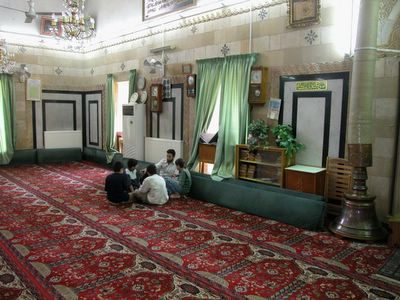
A religious lesson at the Mosque of Ibn Al-Arabi in Salhieh, Damascus.
Muhyiddin Ibn Arabi (1165-1240) is one of the most famous Muslim philosophers. He was born in southern Spain and lived during the golden era of openness and tolerance in Arab-ruled Andalusia. He spent years traveling around the Arab world before finally settling in Damascus, where he completed his greatest book Al-Futuhat Al-Makkiyyah (Meccan Revelations), which is an encyclopedia of Sufism (Islamic mysticism) and Sufi teachings. He was buried in Damascus; and the Mosque, pictured above, was built in his honor by Ottoman Sultan Selim I in 1516.
Throughout his life, Ibn Arabi preached tolerance among all faiths. In one of his most famous poems, he considers his heart "a center of love":
O Marvel! a garden amidst the flames.
My heart has become capable of every form:
It is a pasture for gazelles and a convent for Christian monks,
and a temple for idols and the pilgrim's Kaa'ba,
and the tables of the Torah and the book of the Quran.
I follow the religion of Love:
Whatever way Love's camels take,
that's my religion and my faith.
5/25/2005
Founding Father

Rida Said Street leading to the Headquarters of Damascus University.
Rida Said (1876-1945) is one of the founders of Damascus University. He studied medicine in Turkey and served in the Turkish Army during the Balkan War. He was the mayor of Damascus in the hardship days of World War I, during which most schools and colleges in Damascus were closed. After the War, he lobbied for the revival of educational institutes in Damascus, and in 1919 he became the President of the newly established Syrian University, the first state-run university in the Arab World. He kept the position until 1936.
The pink building in the background, to the left of the University Headquarters, is that of the old National Hospital (dating back to 1899). A few years ago, it was renovated and turned into a conference center that also carries the name of Rida Said.
5/20/2005
Spring Again?
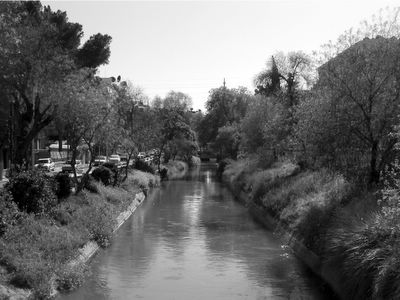
Shortly after President Bashar Al-Assad assumed power in the year 2000, Syria witnessed a period of relative freedom of expression, during which political forums where opened for an extensive public debate, and a newborn civil society movement started to push for reform and change. What had been known then as the "Damascus Spring" came to an end in early 2002, when the government closed down most forums and arrested many activists.
Now the country is living a similar atmosphere. Everybody is talking about the changes that are expected to take place after the upcoming Regional Congress of the ruling Baath Party in June. In newspapers, on satellite TV channels and on the web, Syrians are participating in a debate about the future of their country. Although the increasing freedom of expression is most clearly noted on the internet, you can also feel it on the street; people who seemed to have no interest in politics now boldly express their views on change and reform.
In Damascus, for the first time in years, there is hope in the air: It will be spring again!
Update (24.5.2005): No. Not yet.
Picture: Barada River at Al-Jisr Al-Abyad
5/16/2005
Green Meadows

The old buildings of Damascus International Fair were raised to the ground after the opening of the new Fair Grounds off the Airport Highway. Fortunately, earlier rumors that the old Fair grounds will be invested by the influential businessman R. M. turned out to be false. It seems that the Governorate of Damascus has finally decided to turn the area into a public park, with cafes, restaurants, shops and other tourist facilities. The area will also regain its old historical name: Al-Marj Al-Akhdar (Green Meadows).
Al-Marj Al-Akhdar was a huge green space located outside walled Damascus. It was where the King of Germany camped with a huge Crusader army and besieged Damascus for four days before a failed attempt to capture the city in 1148. It was where Sultan Baybers built Al-Ablaq Palace in 1260. Damascenes used to go there for picnics; and for a period of time, they used to send their ill and dying animanls to spend their last days in a beautiful green environment. In the mid-1950s, the area became the Damascus International Fair Grounds. The Fair was annualy held there till 2003.
Now how long will it take to bring Al-Marj Al-Akhdar back to life again? The nearby 3-year-old mess in Omayyad Square makes everybody pessimistic!
5/13/2005
Condolences
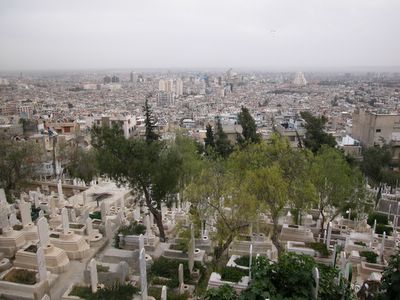
In Damascene tradition, condolences are accepted separately by the men and the women of the family. In the case of the former, the family of the deceased sit in a row near the door to see all those coming and going, and every time a mourner comes in they stand up and welcome him, shaking his hand and then leading him to sit alongside the rest of the mourners, while the sheikh reads from the Quran. Every time a group of mourners comes, another group leaves. Passing the parents on the way out, they shake their heads exclaiming, "May God compensate you for your loss" to which the family members respond "God thank you for what you have done." They must accept condolences on three consecutive evenings.
As for the women relatives, one of them volunteers to get in touch with the closest of the female relatives, calling them to the deceased person's house to stand in the room in which they accept condolences, the 'asriyya. Thus, all the aunts, parents-in-law, nieces, sisters-in-law, daughters-in-law, and all the closest female relatives come to the house as soon as possible. The older women, of course, are the ones who actually stand in the 'asriyya accepting condolences. This act is one of showing how the deceased person stood with the relatives and the respect they owe him. Sometimes about ten women stand in the 'asriyya and at other times maybe even forty-five women, naturally depending on the deceased person's place in the hearts and minds of his friends and relatives.
Adopted from Siham Tergeman: Daughter of Damascus, English version by Andrea Rugh, Center for Middle Eastern Studies at the University of Texas at Austin, 1994.
5/11/2005
Guided Tour
5/08/2005
Moroccan Battalion
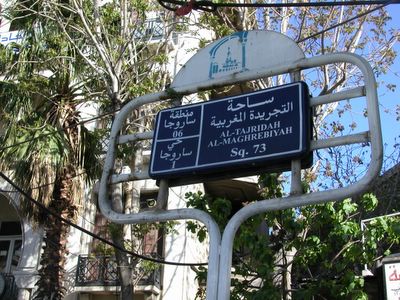
Few people know that official name for Sahat Al-Saba' Bahrat (Seven Fountain Square), a main square in central Damascus, is Al-Tajrida Al-Maghribiyyah (The Moroccan Battalion) Square. A battalion from the Moroccan army was sent to Syria in 1973 to participate in the war against Israel to liberate the occupied Golan Heights. The Moroccans took part in the fiercest battles of the war and lost many soldiers on the slopes of Mount Hermon. In 1974, Al-Saba' Bahrat was renamed in honor of their courageous stand.
5/04/2005
May Rain
5/01/2005
Happy Easter

Orthodox Christians celebrate Easter today (while Catholics celebrated it on March 27). The difference is due to the use of two methods for calculating the date of Easter. Orthodox churches use the Julian Calendar, while Catholic and Protestant Churches use the Gregorian Calendar. There have been various attempts to reach a common date for Easter. In 1997, a meeting in Aleppo sponsored by the World Council of Churches and the Middle East Council of Churches and attended by various representatives of Eastern and Western Churches, issued what has been known as "The Aleppo Statement" which urged all churches to start celebrating Easter on a common date beginning in 2001. However, the suggestion was never implemented and the issue is still a matter of great concern, especially for Middle Eastern Christians, who believe it should be addressed seriously and urgently.
The picture above shows a new Church in a suburb of Damascus that stands as a wonderful symbol of unity among Syrian Christians. The Church of Saint Paul and Saint Peter in the suburb of Dummar is the first church to serve both Orthodox and Catholic communities. It was inaugurated last February by Beatitude Ignatius IV, Orthodox Patriarch of Antioch and All the East, and Gregorius III, the Melkite Catholic Patriarch. Will the event inspire church leaders to reach a common date of Easter?
4/29/2005
Ottoman Mosque
4/27/2005
Haunted By Her
When I am always haunted by you?
Forgive me if I did not reveal my passion to you
For the sweetest thing about love is concealing.
4/24/2005
In Remembrance
Armenian Syrians today mark the 90th anniversary of the mass deportations and killings of Armenians in Ottoman Asia Minor in 1915. Hundreds of thousands of Armenians then sought refuge in Syria to escape the killings, famine and economic difficulties. Today, they constitute an integral part of the Syrian society. 75 percent live in the northern city of Aleppo and nearly 20 percent in Damascus. The rest are scattered in other Syrian cities and towns. Throughout the years, Syrian Armenians were able to maintain their traditions and customs, and to preserve their culture and language. Most belong to the Armenian Orthodox Church. The picture shows a memorial stone in the Armenian Church in Damascus:
"In Memory of Our Martyrs. 24 April 1915".
Addendum: Read about Aleppo's observance of the anniversary at Aleppo Post
4/23/2005
The Lycée

The Lycée Francais School was established in 1930 by the Mission Laique Francaise (French Laic Mission). Its beautiful building on Baghdad Street was designed by French architect Victor Erlanger. In 1967, the school was nationalized, along with other private schools in Damascus and was renamed Lycée Al-Houriet (Freedom). In 1994, it was renamed Lycée Bassel Al-Assad, but it's still known among Damascenes simply as Al-Laique.
4/21/2005
Mercy Upon Mankind

Muslims today celebrate Al-Mawlid Al-Nabawi, the birthday of Prophet Muhammad (PBUH). In Damascene traditions, which are less practiced today, Al-Mawild used to be a widely celebrated occasion. Neighborhoods would compete in organizing large 'arada processions; and mosques would be illuminated with colorful lanterns or lamps and filled with people who gather to listen to the story of Muhammad's birth and life, and to inshad (religious singing) in praise of the prophet, then go back home with small packs of white Mulabbas (almonds covered with sugar) which is especially made for the occasion.
This banner on a house in Muhajirin, opposite to Al-Murabit Mosque, carries a verse from the Holy Quran (21:107), summarizing the message that was delivered by Muhammad:
"We sent thee not, but as Mercy for all mankind"
4/17/2005
Independence Day
Our good hopes and heart beats
Surround the flag that unites the Nation
Does it not have the black color of every eye?
And the red color of every martyr's blood?
From the Syrian National Anthem
(Lyrics by Khalil Mardam Bey, Music by Flayfel Brothers)
4/15/2005
Humble Home

President Shukri Al-Quwatli (1892-1967), one of the heroes of Syrian independence, lived in this humble rented apartment in Al-Jisr Al-Abiyad neighborhood. Al-Quwatli was the most prominent leader of the National Bloc that led political resistance against the French mandate. He served as President in the periods 1943-1949 and 1955-1958, which were the golden years of Syrian democracy. Al-Quwatli left Syria after the military coup by Baath Party in 1963. He lived in Geneva then in Beirut until his death on June 30, 1967, only twenty days after Syria's disastrous defeat in the Six Day War and the loss of the Golan Heights to Israel.
4/13/2005
Faroukh Shah
4/11/2005
The Circumciser
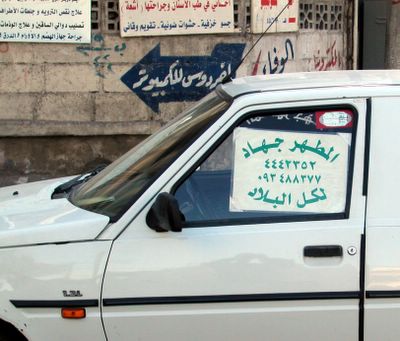
In Damascene tradition, a boy's circumcision used to be an important event attended by family and relatives who fill the house before the arrival of the "circumciser." Enthusiastic visitors shouting greetings and special 'arada songs would make it difficult for the crying poor boy to be heard. After the boy is officially circumcised, he would be proudly paraded in the neighborhood with a red tarboosh on his head and with him holding the white ghallabiyeh robe a few inches away at the front, so that to avoid any possible pain. Today the circumcision is no longer celebrated, as boys are usually circumcised at hospital during their first week of life. However, some people still prefer to do it at home with the help of a "circumciser," like this one announcing his services and cellphone number to passers-by.
4/08/2005
Burial Place
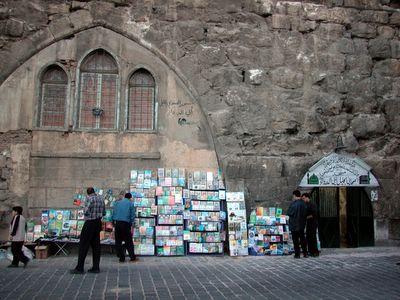
Outside the mosque and burial place of Abu Al-Darda' in the Citadel of Damascus. Abu Al-Darda' was a companion of Prophet Mohammad (PBUH) and one of the narrators of Hadith (sayings of the Prophet). After the Muslim conquest of Syria, he resided in Damascus and became the city's judge during the reign of Caliph Uthman Ibn 'Affan. He died in 653.
4/06/2005
White & Pink
4/03/2005
Papal Prayer

I remember when Pope John Paul II visited Syria in 2001. The Pope held a mass in Al-Abbasiyeen Stadium in Damascus and visited the Umayyad Mosque, becoming the first Catholic pontiff to enter a Muslim place of worship. In an address at the Mosque, in the presence of late Grand Mufti Sheikh Ahmad Kuftaro, the Pope said:
"For all the times that Muslims and Christians have offended one another, we need to seek forgiveness from the Almighty and to offer each other forgiveness [...] May the hearts of Christians and Muslims turn to one another with feelings of brotherhood and friendship, so that the Almighty may bless us with the peace which heaven alone can give. To the One, Merciful God be praise and glory for ever. Amen."Later during his landmark visit, the Pope went to Quneitra, a town in the Golan Heights liberated from Israeli occupation in 1974. Standing in a small church that was burnt and ransacked by the Israelis, the Pope prayed for peace and justice in the Middle East:
"From this place, so disfigured by war, I wish to raise my heart and voice in prayer for peace in the Holy Land and in the world [...] Lord, you speak words of peace to your people and to all who turn to you in their hearts. We pray to you for the peoples of the Middle East. Help them to break down the walls of hostility and division and to build together a world of justice and solidarity [...] May they be inspired to oneness of heart and mind, in working for a world that will be a true home for all its peoples. Salam! Salam! Salam!"Today the church is still deserted as it has been for 38 years, still waiting for the Pope's prayer to be answered... May his soul rest in peace.
4/02/2005
Safe Cycling

Some suggest that encouraging people to use bicycles in downtown Damascus will help reduce traffic jams and air pollution in the city. However, cycling in Damascus can be very dangerous, especially with the carelessness of motor-vehicle drivers, the weak enforcement of speed limits and other traffic rules, and the absence of special bicycle routes.
3/30/2005
Lebanese Architect
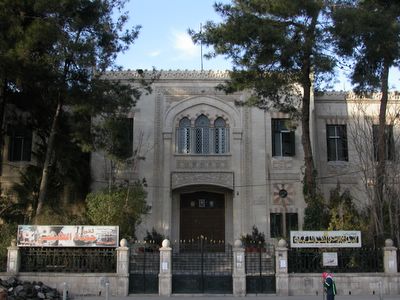
Al-Tajheez School was established in 1933 to replace Maktab 'Anbar as the main high-school in Damascus. It was later renamed after Jawdat Al-Hashimi (1887-1955), its founder and first director. The building was designed by the famous Lebanese architect Youssef Aftimos (1866-1952), who also architected the Beirut Municipality building and the clock tower at Beirut's Grand Serail.
3/27/2005
Happy Easter

The Convent of Our Lady of Seidnaya (located 27 km north of Damascus and dating back to 547) has an interesting story:
Justinian I, Emperor of Byzantium, came to this desert, where his army encamped and soon suffered thirst for lack of water. When they despaired, the emperor saw a beautiful gazelle off in the distance. He vigorously gave chase, hunting the animal until it tired and stopped on a rocky knoll and approached a spring of fresh water, but without giving the emperor the opportunity to shoot it. Suddenly, it transformed into an icon of Virgin Mary, which shone with a brilliant light. A white hand stretched forth from it and a voice said, "No, thou shalt not kill me, Justinian, but thou shalt build a church for me here on this hill." Upon his return, Justinian related what he had seen to his subordinates and ordered them immediately to draw up a plan for the contemplated church. After some time had passed and the architects were unable to resolve the problems of the plan, the Holy Virgin (the gazelle) reappeared to Justinian in a dream and confided a magnificent plan to him for a convent, of which she would be the Protectress. It is said that the basic structure of the convent follows this plan to this day. The convent soon gained such renown that it came to be ranked second only to Jerusalem as a place of pilgrimage, and nuns from every corner of Syria, Egypt, and other lands flocked to it. (Text from Saidnaya.com)
3/25/2005
Earliest Worshipper
3/24/2005
The Eagle

The Syrian national emblem is a reproduction of the Eagle of Saladin. This mediveal Arab hero used a golden eagle as his coat of arms and had it painted on the flags his armies carried during many victorious battles. Other Arab countries have also adopted an Eagle as their emblem, including Egypt, Libya, Palestine and Iraq. This giant eagle is engraved on the wall of the Telecommunications Building in Saadallah Al-Jabiri Street. The shield in the center carries the three stars of the old Syrian flag and the inscription on the ribbon reads "Syrian Republic." This is a bit different from the current coat of arms which has two stars (since 1982) and the words "Syrian Arab Republic" on the ribbon (since 1961).
3/22/2005
Oh-My-God Square

Omayyad Square has been closed to traffic for 4 days now, while construction works are accelerated in the hope of ending a long nightmare for Damascene drivers. It's been three years since the central Omayyad Square was turned into a mess for the sake of a 300-meter-long tunnel that connects Al-Mazzeh and Shukri Al-Quwatli streets. During that period, what used to be Damascus' most beautiful square has been filled with huge construction vehicles, confused traffic police and cars trying to avoid endless holes and humps. Al-Iqtisad Magazine commented: "O-My-God Square" may be a better name.
3/21/2005
Mother's Day
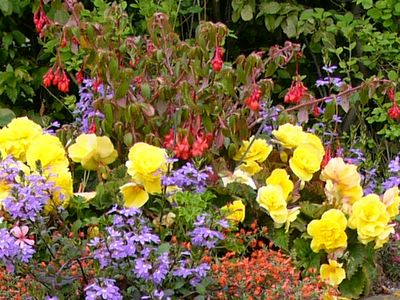
It's a bouquet of flowers and kel seneh wintee salmeh, Mama. "May every year bring you good health, mother" before planting a kiss on her hand and gently touching it to the forehead, as a sign of respect and gratitude. It's resting for moments in her warm embrace and feeling this familiar sweet scent. It's listening to Fayzeh Ahmad's "Sitt Al-Habayeb" (the beloved of all beloved) being repeated on radio all day long, and choking with tears when Fairouz sings:
My mother, my angel,
My everlasting love...
Your arms are still my swing,
And I am still a child.
3/18/2005
Stone By Stone
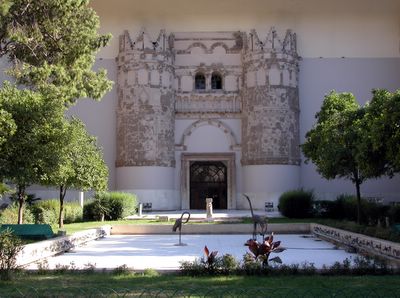
The facade of Al-Hayr Al-Gharbi Palace is one of the most impressive features of the National Museum of Damascus. The palace originally stood 60 km southwest of the ancient city of Palmyra, in the heart of the Syrian desert. It was built by the Omayyad Caliph Hisham Ibn Abdel-Malik in 728 at the crossroads of trade routes connecting Damascus, Baghdad and Arabia. In 1939, the Palace's facade was brought to Damascus and reconstructed, stone by stone, at the entrance of the National Museum. It is one of the rare examples of Persian and Byzantine influences on early Omayyad architecture.
3/16/2005
Beit Baroudi
The land of Arabs is my homeland
From Damascus to Baghdad
And from Najd to Yemen
To Egypt and Tatwan*
For no border separates us
And no religion divides us.
Our mother tongue unites us
With Ghassan and Adnan**
* Tatwan is a city in Morocco. ** Ghassan and Adnan are names of ancient Arab tribes. Click here to download the song and here to read the lyrics in Arabic.
3/14/2005
Festival of Colors
3/11/2005
Side By Side
Walking along the Eastern Wall of the Umayyad Mosque before the Friday Prayer.
The Umayyad Mosque stands on a site that has been previously occupied by an Aramaean temple of Hadad, a Roman Temple of Jupiter and finally a church dedicated to St. John the Baptist. When Muslim armies entered Damascus, they established a mosque in the east side of the temple, leaving the Church intact. For more than seventy years, Muslims and Christians prayed side by side inside the walls of the Temple. They used the same main gate as an entrance; Muslims prayed on the east side and Christians prayed on the west side. In 705, the Caliph of Damascus, now the capital of the world's largest empire, wanted to build a huge new mosque and asked Christian leaders to cede their share of the land to him. After long negotiations, the Christians accepted the Caliph's offer to compensate them with four new churches; among them is the famous Mariamiyyah Church (Church of Mary) in Bab Sharqi.
3/09/2005
Rally Day
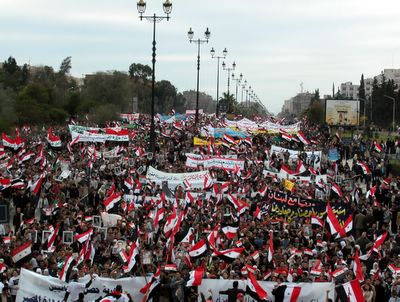
Tens of thousands today crowded al-Mazzeh and 'Adnan al-Malki streets up to the Presidential Office in Rawda to show support for President Assad against the mounting US-pressures. It was noted that unlike previous similar events, the Syrian flag dominated the rally and there were very few Baath Party flags (was this a good effect of the Beirut protests during which only the Lebanese flag was raised?) It was also noted that some people carried small placards saying: "Yes to reform and democracy in Syria" and calling for "Reform.. Democracy... Now!" but adding: "Support Our leader and Make a Better Syria" and "Mr Bush: We Need Our Democracy... Not Yours."
3/08/2005
Every Living Thing
"And we made from water every living thing"
3/06/2005
Young Country
3/05/2005
Pulling Out

President Bashar Al-Assad addressed the Parliament today about the Lebanese crisis. Assad announced a plan to withdraw Syrian troops to Bekaa valley, as a step towards full withdrawal. When this withdrawal is completed, Assad said, Syria would have fulfilled its obligations under the Taif agreement and UN Security Council resolution 1559. Will this be enough to stop the barking of Bush and others? I don't think so.
3/04/2005
Laying Mats
3/03/2005
Cleaning Action

Al-Abed Building is one of the finest examples of early 20th century architecture in Damascus. It was constructed in 1910 by the Spanish architect Fernando de Aranda (1878-1969), who is thought to be the same architect who designed the Hijaz Railway Station. For decades, the building has been victim to the dirtiness and pollution of downtown Damascus. Now it seems to be undergoing a long-waited cleaning action.
3/02/2005
Her Sons

"Those who want to get with the latest US program must put the blame on Syria. What for? Doesn't matter in the least. Whether it is for the two world wars, the demise of Elvis or sinking the Titanic, Syria makes a handy and eminently fashionable punching bag..."
-- Linda Heard in Arab News
"...This is the reality we must deal with. It's not important to approve or refuse accusations against us. We must read what's behind them; and what's behind them is now obvious: The beginning of an attack against Syria. Maybe we had a lot of differences in the past, maybe we will have lots in the future (...) But Syria will remain our great love. Syria will remain the dream that unites us (...) Let's love Syria, pray for her, defend her. Today Syria needs all her sons, needs us to be her sons, just her sons."
-- Nidal Maalouf in Syria News (translated)
2/28/2005
Aleppan Wisdom
Words of wisdom on the show window of a souvenir shop in Aleppo:
"A civilized person only spits in his handkerchief! Cleanliness is part of faith."
2/26/2005
Hotel Controversy

It was announced today that construction works of the Four Seasons Hotel have been completed and that the Hotel will officially open next summer. There has been a lot of controversy in Damascus about the Hotel, which is 65% owned by the Saudi Billionaire Al-Walid Bin Talal, 17% by the Governorate of Damascus and 17% by the Ministry of Tourism:
( - ) Many feel that the building's design does not fit the area. Towering in Shukri Al-Quwatli Street and overlooking Barada River and the historic Tekiyyeh Mosque, the huge block of glass and marble now dominates the skyline of central Damascus. Some have complained about the fact that the hotel consumed a large part of Al-Menshieh Park and surrounded the eight-century-old dome covering the tomb of Faroukh Shah, the nephew of Saladin.
( + ) This is going to be the largest hotel in Syria and the first five-star hotel to be opened in Damascus in nearly 2 decades. In addition, the new Hotel occupies an advantageous "strategic" site in the heart of Damascus. It will boost the tourist industry in the country and create an atmosphere of competition that will result in better tourist services. The building looks great, especially when lit at night; it gives a touch of modernity to the center of the nation's capital, the home to an estimated 5 million people.
2/25/2005
Damascene Breakfast

A no-longer-new trend in Damascus is opening restaurants and cafes in restored traditional Damascene houses of the Old City. As well as making good money for investors, this helped to preserve many beautiful houses that were neglected for a long time and to breathe life back into the Old City. An example is Beit Jabri, an 18th-century house with 23 rooms that was turned into a restaurant in 1996. On Friday mornings, Beit Jabri is crowded with people who gather for a traditional Damascene breakfast of fatteh or tess'iyeh: A mixture of broken pieces of toasted pita bread and chickpeas, covered with a special sauce made of yogurt and tahini (sesame seeds paste) and served in two types: with olive oil or with samneh (ghee).











